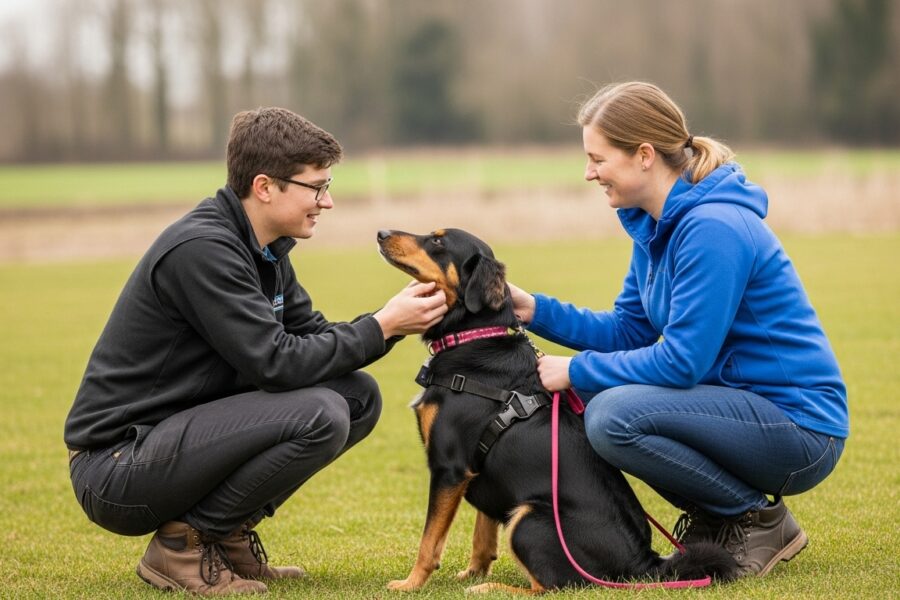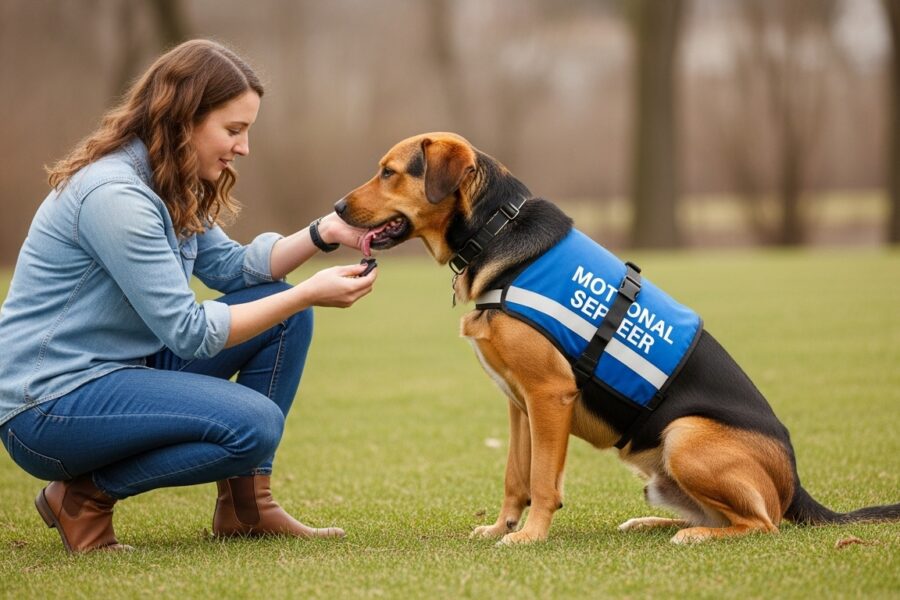Bringing home a new puppy is an exciting adventure, but it’s not without its challenges. From chewing shoes to barking at squirrels, puppy misbehavior can test even the most patient pet parent. The good news? You don’t need harsh corrections or dominance-based tactics to raise a well-behaved pup. Positive reinforcement puppy training is a science-backed, compassionate approach that builds trust, encourages good habits, and fosters a lifelong bond between you and your furry friend.
Table of Contents
In this guide, we’ll explore how positive reinforcement works, why it’s effective, and actionable tips to transform your pup’s behavior—no yelling or punishment required.
What Is Positive Reinforcement Puppy Training?
Positive reinforcement is a training method that rewards desired behaviors to encourage repetition. Instead of scolding a puppy for mistakes, you focus on celebrating what they do right. For example:
- Treats, praise, or playtime when your pup sits calmly.
- Ignoring unwanted behaviors (like jumping) while rewarding calm greetings.
- Using a clicker to “mark” the exact moment your puppy performs a correct action.
This method taps into your puppy’s natural desire to seek rewards, making learning fun and stress-free. Studies show that dogs trained with positive reinforcement exhibit fewer behavioral issues and stronger bonds with their owners.
Why Positive Reinforcement Works Better Than Punishment
Traditional training often relies on correcting “bad” behavior with leash jerks, loud noises, or physical discipline. Unfortunately, these methods can:
- Damage trust and increase anxiety in puppies.
- Lead to fear-based aggression or avoidance.
- Fail to teach your pup what they should do instead.
Positive reinforcement puppy training, on the other hand, focuses on clear communication. By rewarding good behavior, you:
- Motivate your puppy to repeat actions that earn praise or treats.
- Build confidence and reduce stress.
- Create a happy, eager-to-learn attitude.

How to Start Positive Reinforcement Puppy Training
1. Use High-Value Rewards
Find what your puppy loves most: tiny training treats, a favorite toy, or enthusiastic praise. Use these rewards immediately after they perform a desired behavior to reinforce the connection.
2. Keep Sessions Short & Fun
Puppies have short attention spans. Aim for 5–10 minute training sessions multiple times a day. End on a positive note to keep them excited for the next lesson.
3. Start with Basic Commands
Teach foundational skills like “sit,” “stay,” and “come” using rewards. For example:
- Hold a treat near your pup’s nose, then slowly lift it upward. As their head follows, their bottom will naturally lower into a “sit.” Say “yes!” or click, then reward.
4. Redirect Unwanted Behaviors
If your puppy nips or chews furniture, avoid scolding. Instead, redirect them to an appropriate toy and reward them for using it.
5. Be Consistent
Everyone in your household should use the same cues and rewards. Mixed signals confuse puppies and slow progress.
Common Mistakes to Avoid
Even with the best intentions, small missteps can hinder training:
- Inconsistent timing: Reward within 1–2 seconds of the desired behavior.
- Overusing treats: Gradually replace food rewards with praise or play as your pup learns.
- Expecting too much too soon: Puppies learn at their own pace—patience is key!
Real-Life Success: A Positive Reinforcement Puppy Training Story
Meet Max, a 4-month-old Labrador who loved digging up the backyard. His frustrated owners swapped scolding for positive reinforcement: every time Max played with his toys instead of digging, he earned a treat and a game of fetch. Within weeks, Max’s digging habit vanished—and he mastered “leave it” and “drop it” along the way!
Final Thoughts
Positive reinforcement puppy training isn’t just about teaching commands—it’s about nurturing a confident, happy dog who trusts and respects you. By focusing on rewards instead of reprimands, you’ll turn training into a bonding experience that sets the stage for a well-mannered companion.
Ready to start? Grab some treats, celebrate the small wins, and watch your puppy thrive!
FAQ: Positive Reinforcement Puppy Training
Q1: What exactly is positive reinforcement puppy training?
A: Positive reinforcement puppy training is a method that focuses on rewarding desired behaviors (like sitting calmly or following commands) with treats, praise, or play. By ignoring or redirecting unwanted behaviors and consistently rewarding good actions, you encourage your puppy to repeat those behaviors.
Q2: Will using treats make my puppy dependent on them?
A: Not if done correctly! Start with frequent treats to establish a behavior, then gradually phase them out by replacing food rewards with verbal praise, pets, or playtime. Over time, your puppy will respond to cues without expecting a treat every time.
Q3: How do I stop bad behaviors like biting or barking without punishment?
A: Redirect their energy! For example, if your puppy nips, offer a chew toy instead and reward them for using it. If they bark at the doorbell, practice calm behavior by rewarding quiet moments. Consistency is key—your pup will learn what earns rewards.
Q4: How long does it take to see results with positive reinforcement?
A: It varies by puppy and behavior. Simple commands like “sit” can be learned in a few days with short, daily sessions. More complex habits (like not jumping on guests) may take weeks. Stay patient, consistent, and celebrate small progress!
Q5: Can positive reinforcement work for all breeds?
A: Absolutely! This method is effective for all breeds and ages. Puppies are naturally curious and eager to please, making positive reinforcement a universal fit. Adjust rewards based on your pup’s preferences (e.g., high-energy breeds may respond better to playtime rewards).
Q6: What if my puppy doesn’t respond to treats or praise?
A: Experiment with different rewards. Some puppies are motivated by toys, belly rubs, or a quick game of tug-of-war. Find what excites your pup and use it to reinforce good behavior.
Q7: Is clicker training necessary for positive reinforcement?
A: No, but it can help! A clicker is a tool that “marks” the exact moment your puppy does something right, making it easier for them to understand which action earned the reward. You can also use a verbal marker like “yes!” instead.
Q8: Can positive reinforcement fix severe behavioral issues?
A: For most common issues (e.g., chewing, jumping), yes. However, severe problems like aggression or extreme anxiety may require guidance from a certified professional dog trainer or veterinary behaviorist.
Q9: Is it too late to start positive reinforcement if my puppy is already 6 months old?
A: Never! While starting early is ideal, dogs of any age can learn through positive reinforcement. Older puppies may take slightly longer to unlearn habits, but consistency and patience yield results.
Q10: How do I handle training multiple puppies at once?
A: Train them individually to avoid distractions. Use separate sessions for each puppy, and reward calm behavior when they’re together. This ensures they focus on learning without competing for attention.
Q11: Is positive reinforcement training safe for shy or fearful puppies?
A: Yes! In fact, it’s the best approach for timid pups. Rewards build confidence and trust, helping them overcome fears without added stress. Avoid forcing interactions—let them progress at their own pace.
Q12: How does positive reinforcement compare to other training methods?
A: Unlike dominance-based or punishment-heavy methods, positive reinforcement builds a trusting relationship, reduces fear, and encourages voluntary cooperation. Studies show it leads to happier, more obedient dogs long-term.







Sign up